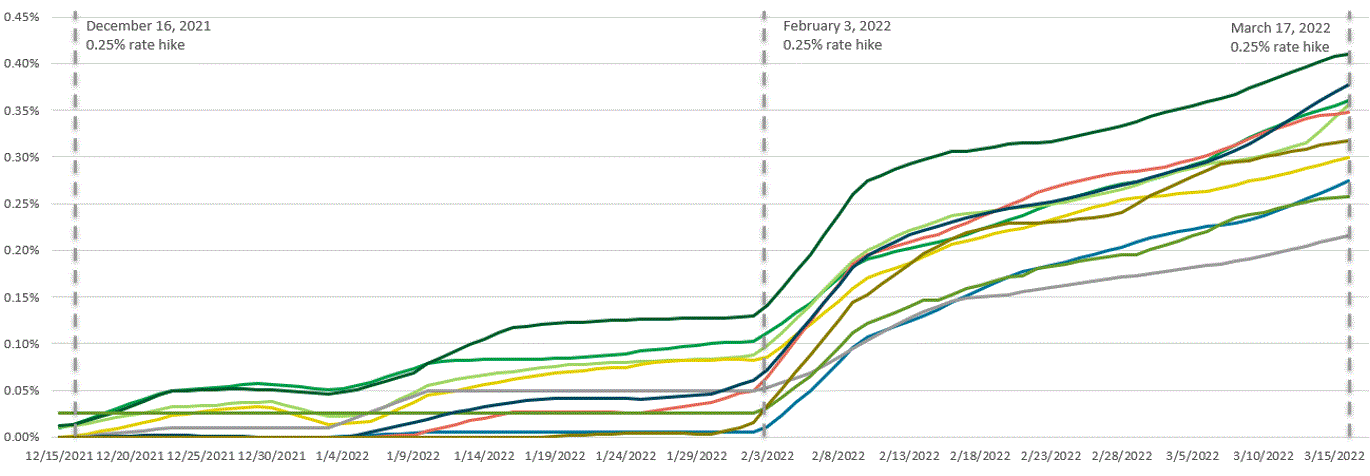
The Advantage of Money Market Funds in a Rising Rate Environment
In March, both the US Federal Reserve and the Bank of England (BoE) raised rates 0.25% to combat rising inflation. That’s good for money market securities, the yields of which respond in short order following central bank hikes.
In March, both the US Federal Reserve and the Bank of England (BoE) raised rates 0.25% to combat rising inflation. That’s good for money market securities, the yields of which respond in short order following central bank hikes. To illustrate, the ten largest sterling money market funds offered on institutional trading platform ICD Portal show 7-day net yields jumped following each of the three 25 basis point increases by the BoE since December. As of March 17, the average 7-day net yield on these funds was 32bps.
7 Day Net Yields* on 10 Largest GBP Money Market Funds on ICD Portal
 *iMoney Net Data
*iMoney Net Data
In February, Bloomberg reported that fund managers are “shortening exposure to interest-rate shifts in their portfolios.” Indeed, in an ICD webinar last month, BlackRock’s Global Chief Investment Officer Rich Mejzak said, “…most funds keep 50% seven days and shorter.” According to money market information provider Crane Data, the weighted average maturities for over 100 money market funds were 10 days or less, as of February 14. By keeping portfolios short, the turnover of new products within the money market fund portfolio enables investors to more quickly benefit from higher yields as rates rise.
With the BoE having already raised rates to 0.75% and the Fed indicating that rates in the US would close out the year at or above 1.9%, treasury teams would do well to put technology in place that enables them to access the broad market and take advantage of opportunities in money funds.
Consider these key capabilities when evaluating trading portals for short-term investments:
- Fund selection – This is commonly the first consideration when treasury professionals evaluate portal technology. Access to a broad selection of the market’s funds enables teams to invest according to their needs, rather than allowing a limited fund selection to dictate their investment strategies. Teams should be able to research funds based on assets under management, weighted average maturities, liquidity, pricing, portfolio composition, net yields and gross yields.
- Streamlined trading and service – An independent investment portal can save time for treasury teams who would otherwise spend 2.5 times more on average executing trades from multiple funds across various portals. Teams will want to avoid multiple statements presented in inconsistent formats, various trade execution channels and multiple wire settlements. Because teams will undoubtedly have trading questions and issues they need addressed immediately, having an experienced and responsive global trade desk in-region that specializes in treasury’s unique requirements is a critical consideration.
- Investment risk management – 86% of the more than 100 participating treasury organizations in ICD’s 2022 Client Survey said they are highly to moderately concerned about concentrating exposure to banks and other counterparties. If other treasury teams share this concern, they should look for a trading platform that provides tools to view portfolio exposures at the counterparty, currency and country levels and to drill down to individual holdings for full transparency.
- Compliance and reporting – Automating active and passive compliance rules and exposure parameters helps teams stay within investment guidelines, while flexible and comprehensive reporting is key for communicating financial metrics and compliance with tax and accounting rules. Look for portal technology that offers a variety of preferences for customization.
- Integration – Portal technology built with an open architecture allows treasury organizations to easily integrate investment data and workflows into cash and liquidity processes in other systems, such as treasury management systems or cash forecasting tools. Integrating portal technology with other systems in treasury’s technology stack makes work seamless and informs accurate decision-making.
Globally, 62% of respondents in ICD’s 2022 Client Survey are currently involved in or planning a treasury transformation, up from 54% last year. For other treasury teams considering technology solutions to optimize cash and investment workflows, understanding key capabilities in portal technology for trading short-term investments will enable them to take advantage of the comeback in yield in the money markets.